SHSAT English Practice Test
Determine whether the underlined portion of the following statement is correct or needs to be revised.
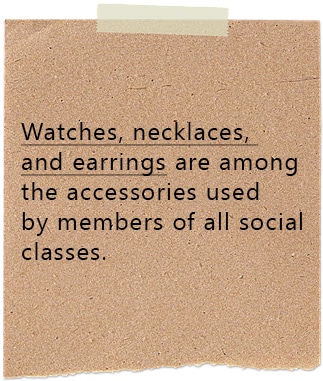
The problem with this sentence is the misplacement of the clause that describes jewelry. By placing “...including watches, necklaces, and earrings.” after “classes” the reader gets the impression that the classes involves different types of jewelry. By moving the clause, choice E and choice D improve the sentence. However, choice D commits the error of using a plural form of “to be” (i.e. are) to refer to a collective noun like jewelry that demands a singular verb (i.e. is). Only choice E places the clause correctly after “jewelry” and ensures that the verb agrees with the subject.
Determine whether the underlined portion of the following statement is correct or needs to be revised.

The original sentence is correct as written. There is no need to change the verb form or tense. Choice C is correct.
Determine whether the underlined portion of the following statement is correct or needs to be revised.
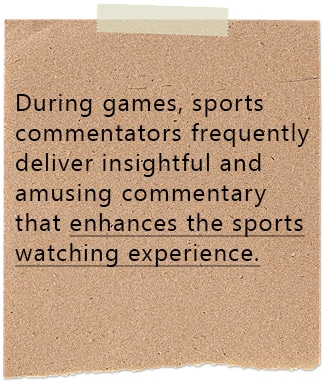
The problem with this sentence is that the second action verb (i.e. enhance) needs to be singular (i.e. enhances) because this verb refers to “insight.” Some readers may believe that because there are two characteristics to the insight (i.e. informative and witty) there should be a plural form of the verb. Choice E and choice A correct this agreement error of the verb; however, choice A is wordy. Obviously fans are the ones who watch sports, so why restate this? Choice E therefore is most direct and grammatically sound.
Determine whether the underlined portion of the following statement is correct or needs to be revised.
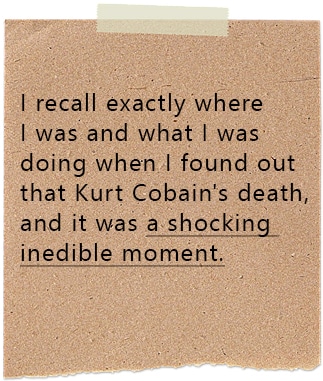
The correct answer is E (A, B, C, and D all have dangling modifier errors, because they aren’t describing what comes after the comma. Indelible means not able to be erased; you wouldn’t say that about a person in this context.)
Determine whether the underlined portion of the following statement is correct or needs to be revised.
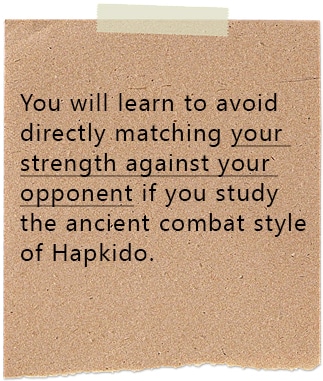
The correct answer is A (B doesn’t say what’s being matched with what. C, D, and E all have some sort of parallelism error.)
Several high school students volunteer in their communities, working with peers, younger kids, and elderly people.
By breaking the parallelism (continuity of a pattern, in this case), the underlined portion of this sentence must be changed. By simply changing “also helping senior citizens” to “senior citizens” the list is clearly discussing people in the community from various age groups. Each other choice besides D uses incorrect pronouns (i.e. his) and/or parallel structure (i.e. also helping senior citizens).
To correct sentence 3, which edit is required?
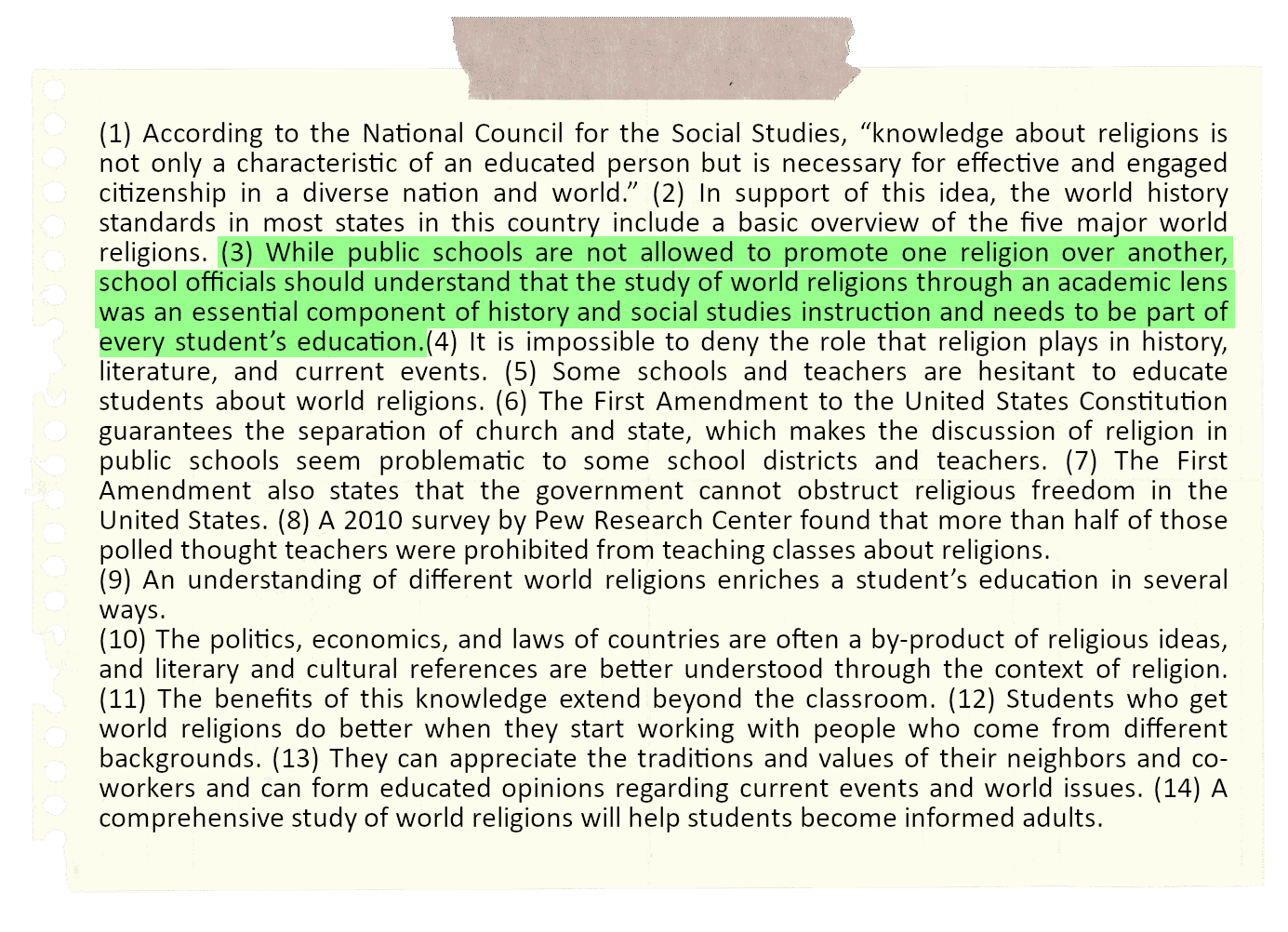
Sentence 3, as well as the rest of the passage, is written in the present tense. The change in Option A would change the verb to the past perfect tense. Option B would change the verb to the present perfect tense, and Option D would make the verb future tense. Only Option C presents an edit that will change the verb to the present tense.
What is the most effective way to combine sentences 4 and 5 in order to clarify the relationship between the ideas?
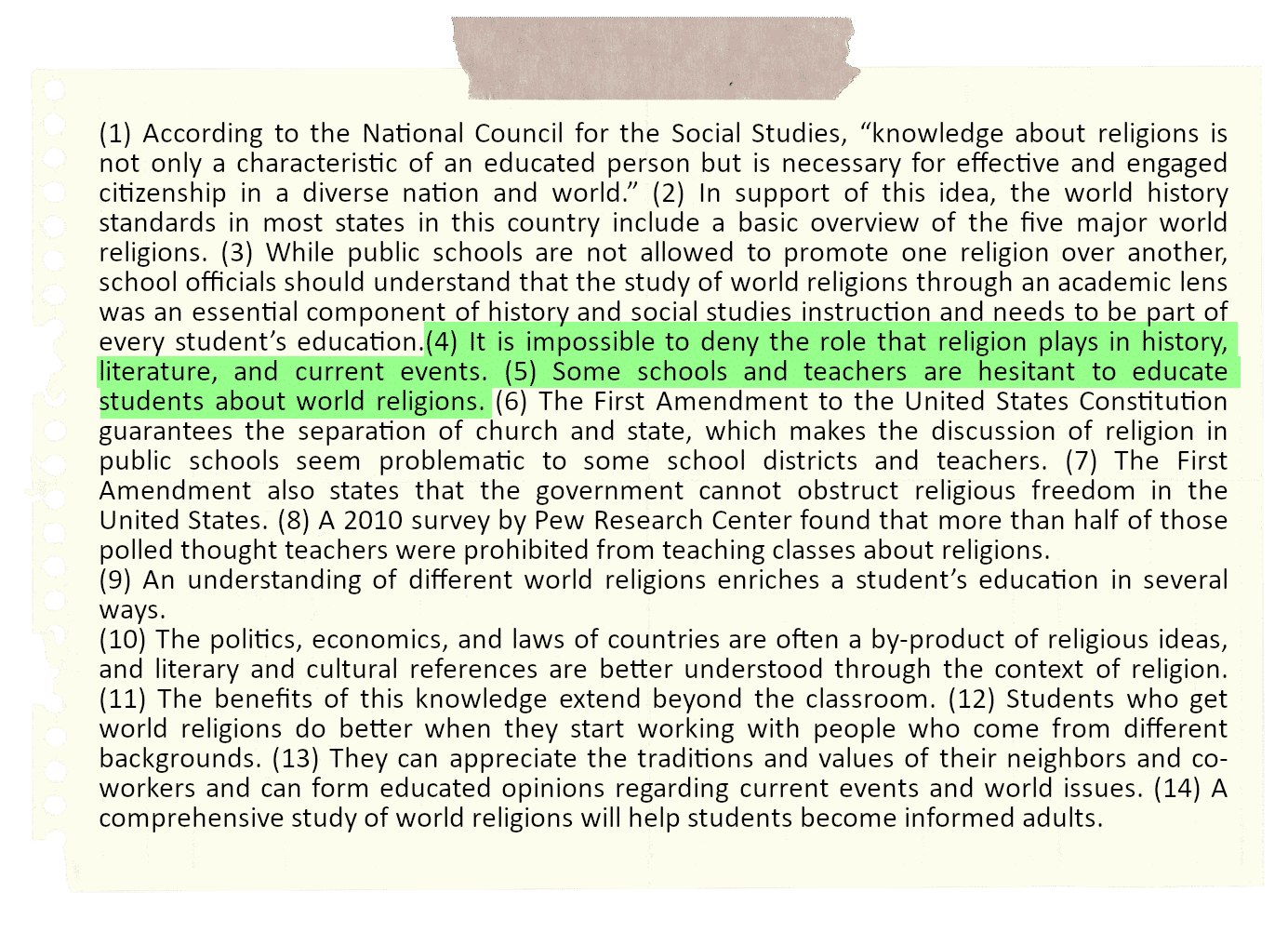
(A) The passage explains that many are aware of the significance of studying religion but that the subject is often not studied explicitly for fear of negative reaction or legal troubles. Option A uses the concessive conjunction “although,” but it appears with the wrong clause. Option B suggests a causal relationship between the ideas, and Option D suggests that the second clause is a result of the first clause. Option C is the only option that accurately uses a concessive conjunction (“even though”) to show the connection between the ideas.
To best support the argument made in the passage, which sentence should come after sentence 6?
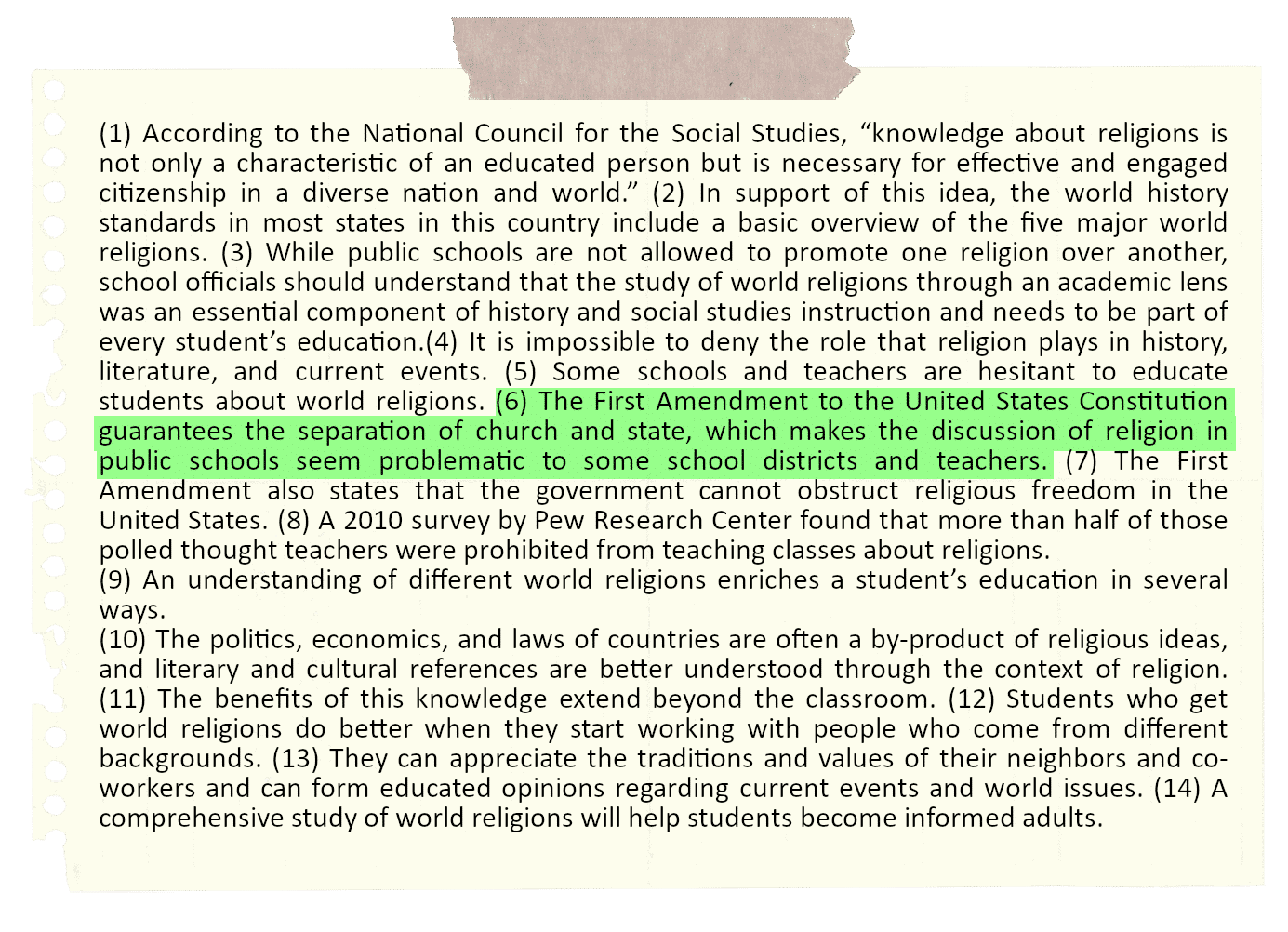
(C) Sentence 6 states the constitutional foundation for the separation of church and state in the United States and suggests that because of this separation, some educators are unsure of how to treat religion in classrooms. The question asks for a sentence that both follows and furthers sentence 6 and relates to the main claim in the passage. Option A and Option B address the risksof teaching controversial ideas but also make statements that do not support the main argument inthe passage. Option D addresses how schools are shifting resources away from humanities education, but it does not connect to the idea that teaching religion may be seen as controversial. Option C is the only option that explains and makes a connection between educators avoiding the topic of religion and subsequent impact on a student’s education.
Which version of sentence 12 use the most exact wording?
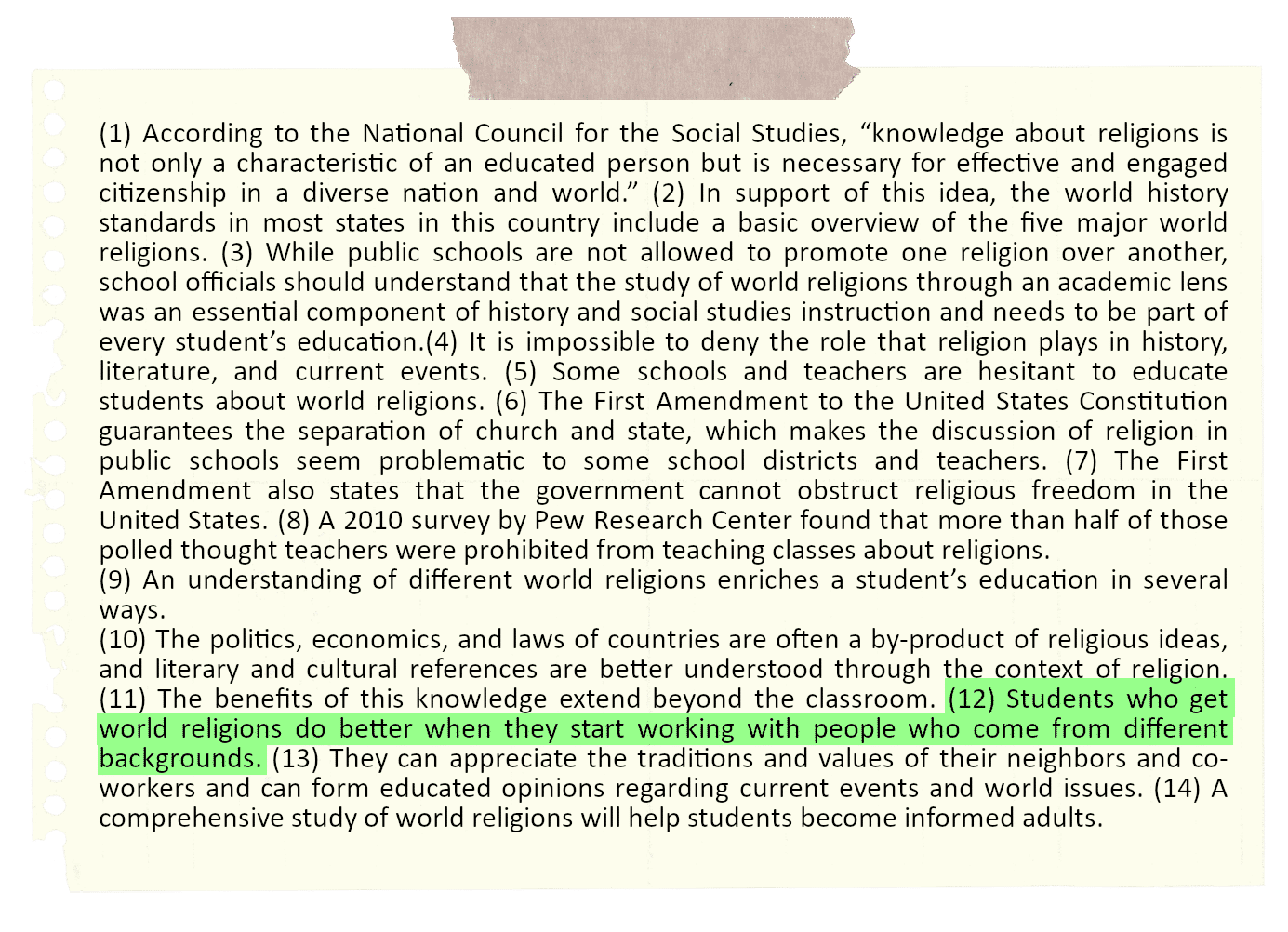
(D) Sentence 12 uses vague and imprecise language and needs to be corrected. The words choice (C: “clued into,” “get along better”; A: “know about,” “more about doing,” “new people”; C: “more aware of how to,” “acquaintances”) and grammatical constructions in Options A, B, and C lack precision. Option D is the only sentence that uses precise and specific language (“understand,” “better equipped,” “diverse colleagues and customers”).
To support the idea stated in the passage, which ending statement should be inserted following sentence 14?
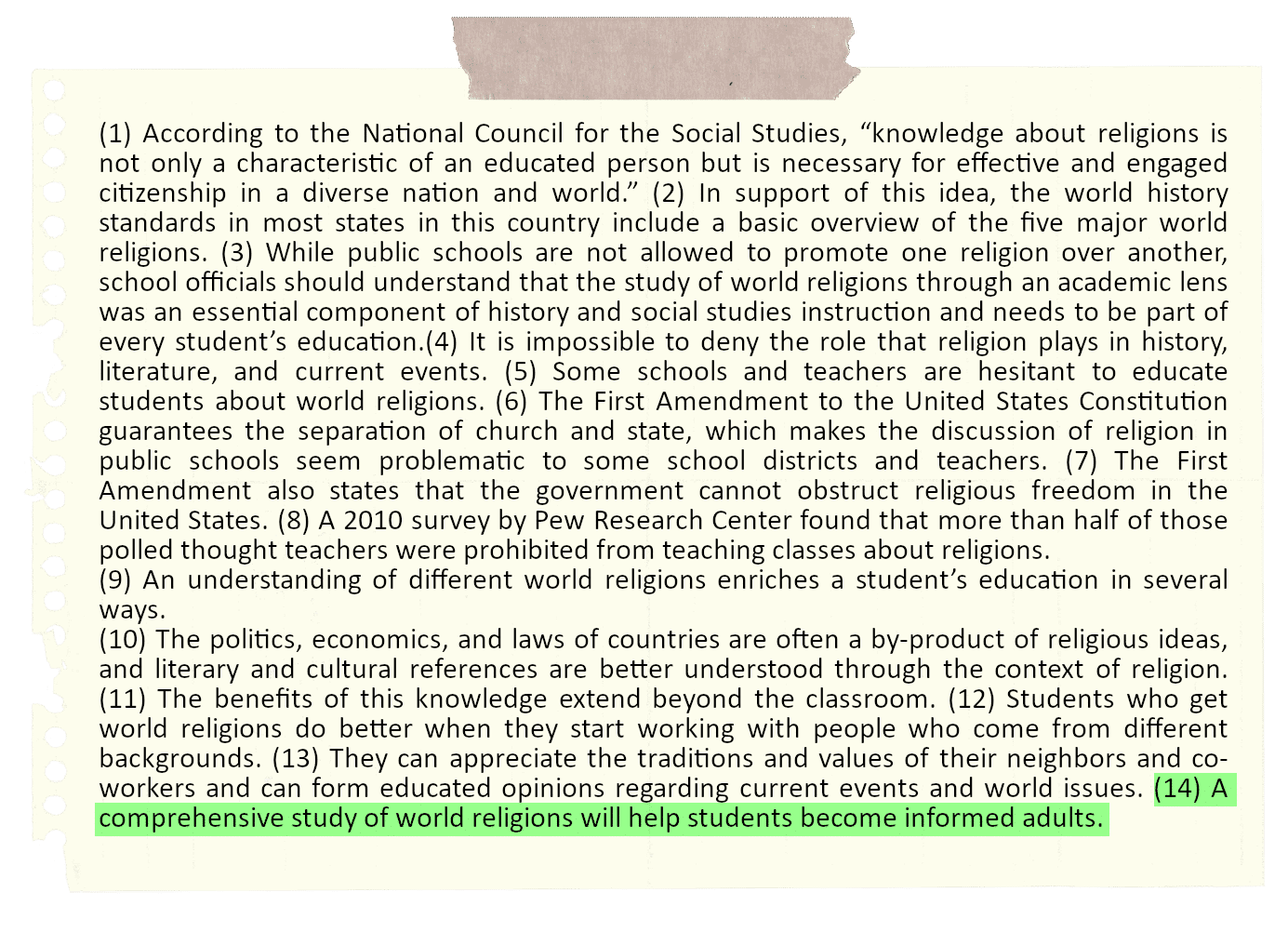
(A) The question asks for a sentence that would follow sentence 14 and also provide a conclusion statement for the passage. Option C suggests that students should learn about all religions, but the passage mainly focuses on the understanding of major religions. It also does not address concerns about discussing religion. Option B urges school officials to make sure students study religion, but it does not address the benefits of learning about religion or ways of alleviating concerns about teaching religion. Option D restates the benefits of studying religions, but it does not address the details from the first two paragraphs from the passage. Option A is the only sentence that logically follows sentence 14 and provides a conclusion for the passage because it restates both the concerns with and benefits of studying religion in school.
Which sentence should be eliminated since it is unrelated to the point given in the passage?
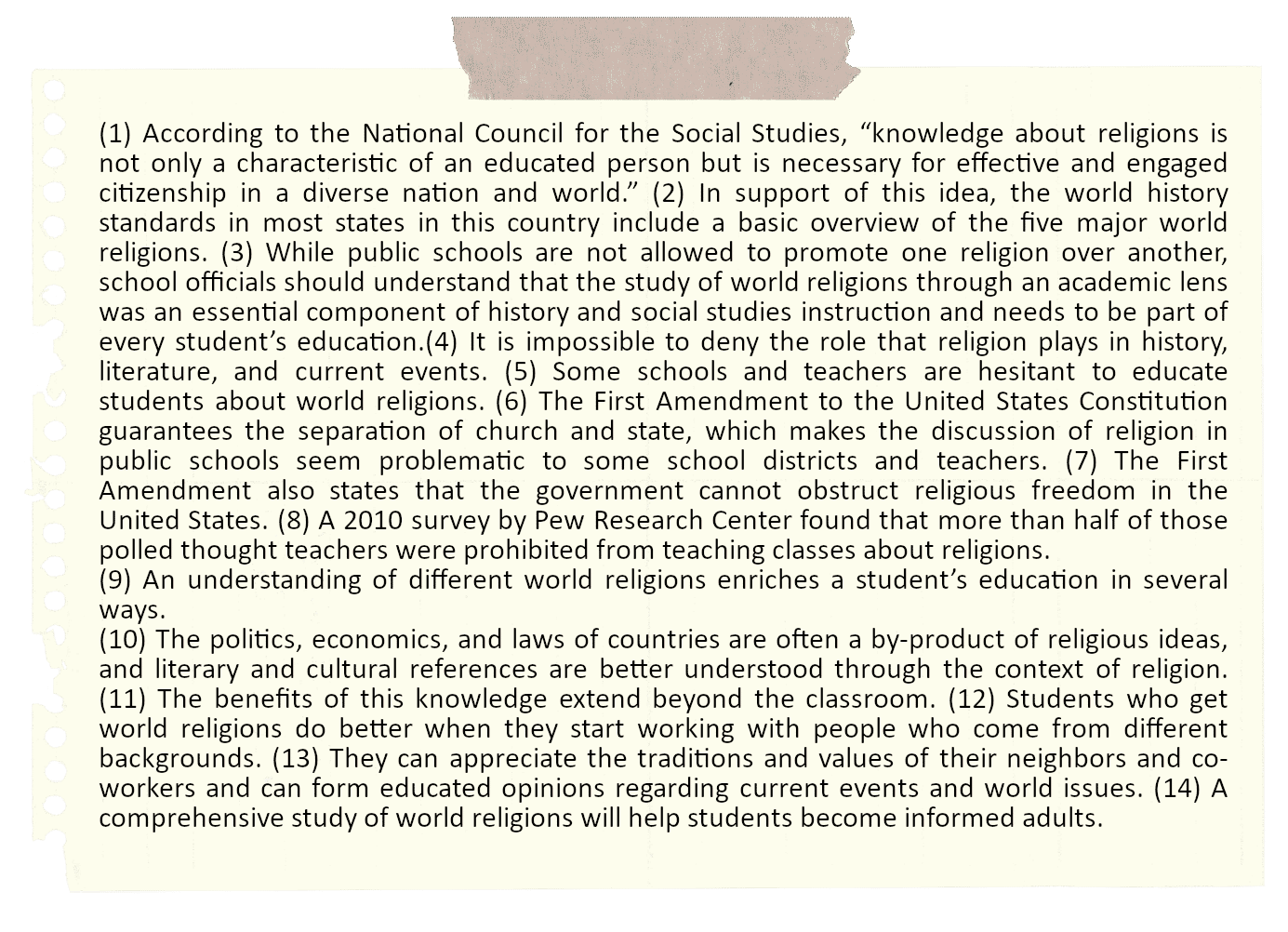
(C) The question asks for a sentence that is irrelevant to the development of the argument in the passage. Option D is relevant to the passage because it highlights that the study of religion is included in most social studies curricula at the state level and is, therefore, considered important to students’ education. Option B is relevant to the passage because it explains the relationship between a country’s religion and the formation of the country’s society/government. Option A is relevant because it continues the discussion of the benefits of being familiar with world religions. Option C, while related to the general topic of religion, introduces the idea of a person’s freedom to practice a religion but does not relate to the discussion about the treatment of the study of religion in schools. This sentence should be removed from the passage.
To begin sentence 11, which transition should be added?
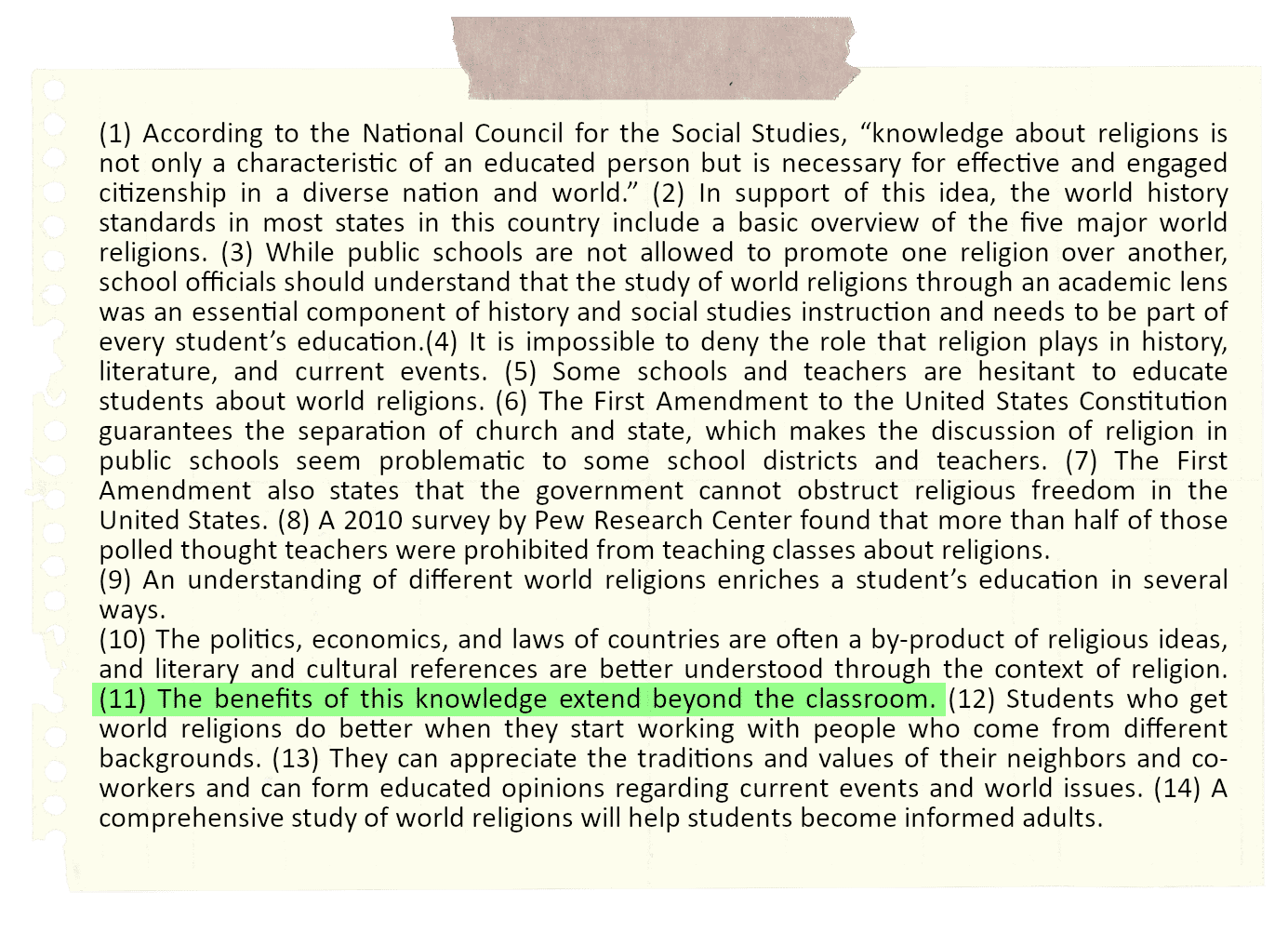
(B) Sentence 11 is leading into another benefit of having an understanding of world religions. Option A suggests that sentence 11 is an effect of sentence 10. Option C suggests that sentence 11 is in opposition to sentence 10. Option D suggests that the idea in sentence 11 should be known or obvious to the reader. Option B is the only option that establishes sentence 11 to be an addition to the ideas expressed in sentence 10.
Which of the following sentences would be the most appropriate to follow and support sentence 8?
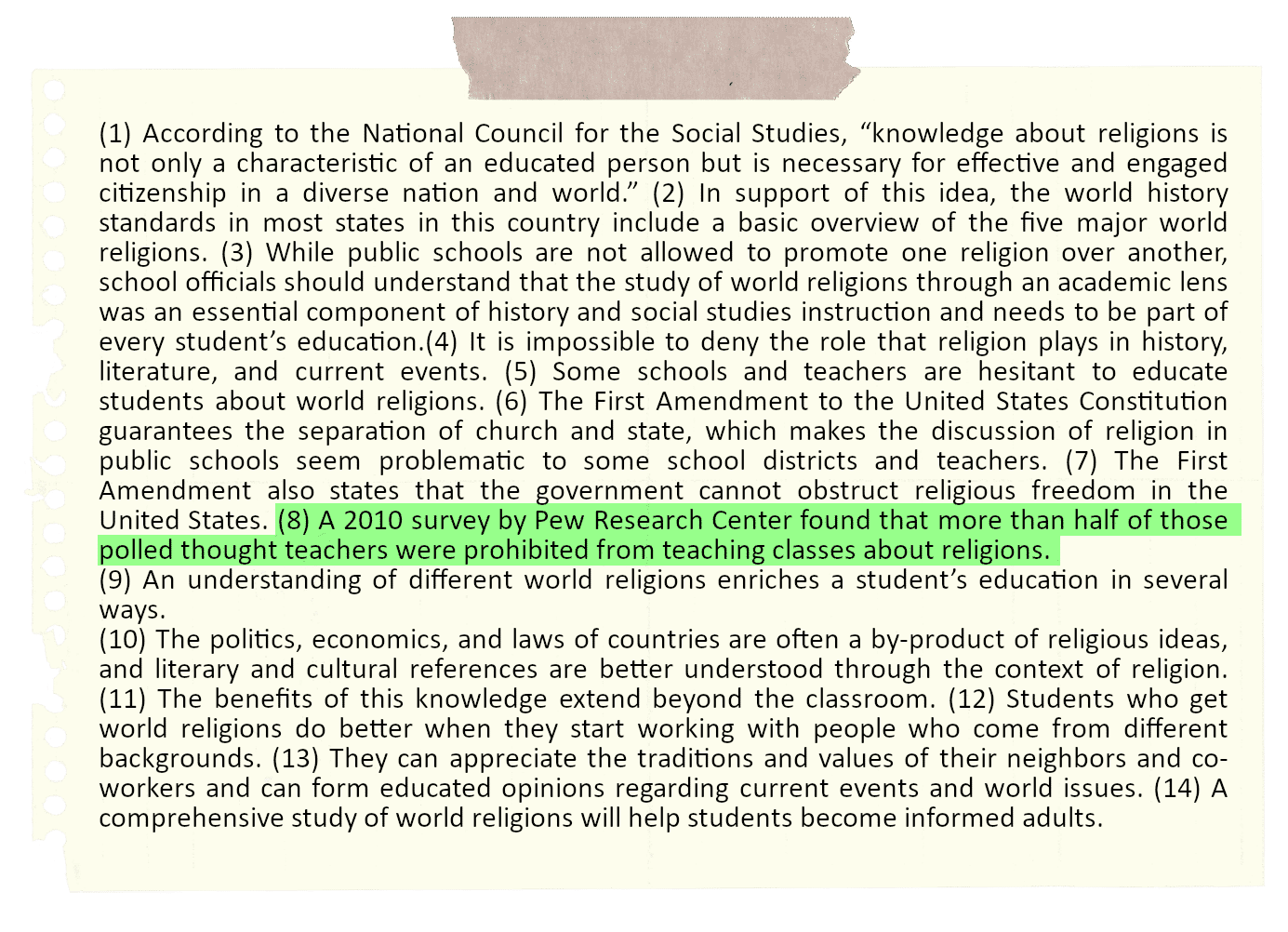
(C) Sentence 8 provides evidence that some people incorrectly believe that it is illegal to teach religion in public schools. The question asks for a sentence that follows and supports this sentence. Option B explains that religious education is often the responsibility of the family, which supports the idea of separation but does not support sentence 8. Option D continues the discussion of the survey, but it does not offer support for sentence 8. Option A also connects to the survey, but it does not address the issue of teaching religion in schools. Option C provides support for Sentence 8 by giving additional results from the survey that strengthen the connection between the information given in Sentence 8 and the main argument in the passage.
To correct a misplaced modifier, which sentence should be revised?
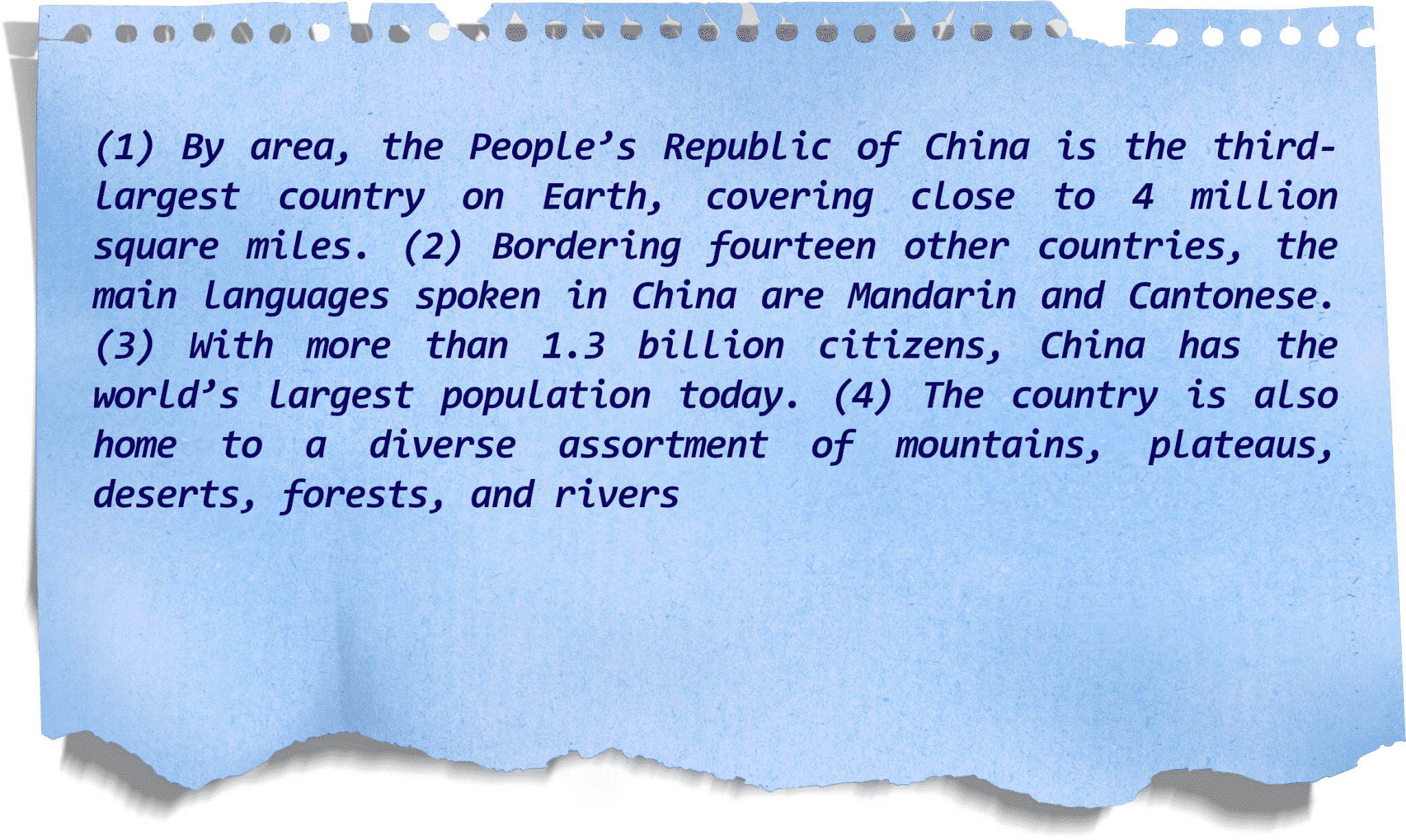
(A) The question asks for the identification of a sentence with a misplaced modifier. In sentence 3, the modifying phrase “With more than 1.3 billion citizens” is correctly modifying “China.” Sentences 1 and Sentence 4 do not have participial or prepositional phrases as modifiers. In sentence 2, the phrase “Bordering fourteen other countries” is incorrectly modifying “the main languages.” This sentence should be revised so that the modifying phrase “Bordering fourteen other countries” modifies “China.”
Larissa's father has a new job that requires him to travel to Albany on a weekly trips, therefore he's looking for a inexpensive reliable vehicle.
Which correction should be made to this sentence?
(A) The sentence in the box needs a comma to separate coordinating adjectives. Option B, Option C, and Option D would each add a comma that would incorrectly break up ideas and clauses. Option A is the only option that places a comma where it is needed between the adjectives “inexpensive” and “reliable.”
Which revision corrects the paragraph's sentence structure error?
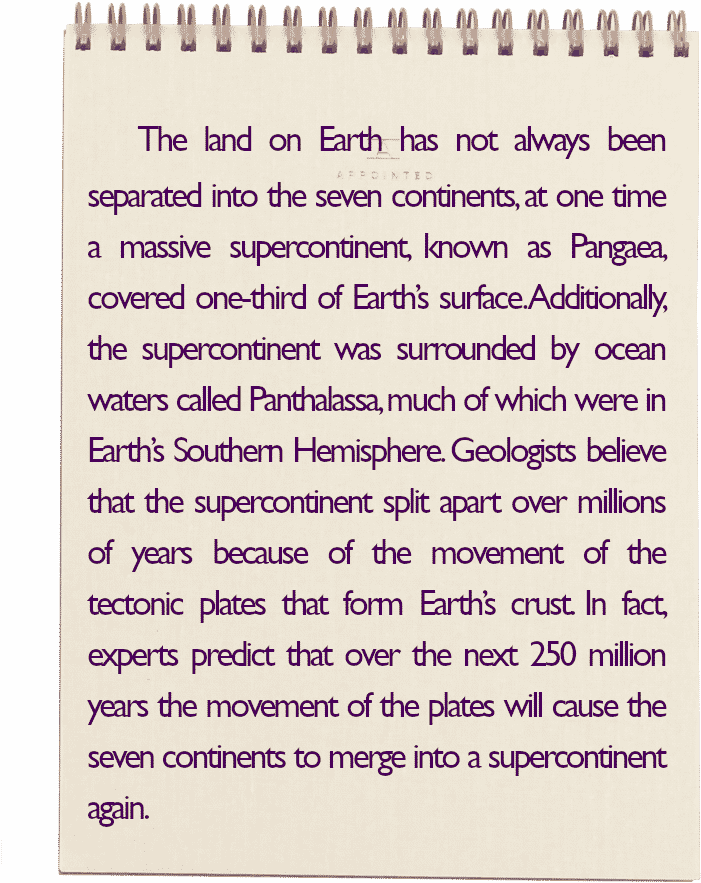
A. Incorrect. While adding a semicolon after “surface” can be considered a correct way to
separate the independent clauses “at one time a massive supercontinent, known as Pangaea,
covered one-third of Earth’s surface” and “Additionally, the supercontinent was surrounded by
ocean waters called Panthalassa, much of which were in Earth’s Southern Hemisphere,” this
change does not address the sentence structure error in the paragraph (the run-on
sentence). The use of a period separating the independent clauses (complete sentences) is
correct as is.
B. Incorrect. Removing the period after “crust” would create a run-on sentence because the
period is needed to separate two complete sentences—“Geologists believe that the
supercontinent split apart over millions of years because of the movement of the tectonic
plates that form Earth’s crust” and “In fact, experts predict that over the next 250 million
years the movement of the plates will cause the seven continents to merge into a
supercontinent again.” A comma after “crust” would combine these sentences into a run-on,
creating a new error in the sentence without fixing the existing sentence structure error (the
run-on sentence) at the beginning of the paragraph.
C. CORRECT. The first sentence of the paragraph is a run-on because both clauses—“The land
on Earth has not always been separated into the seven continents” and “at one time a
massive supercontinent, known as Pangaea, covered one-third of Earth’s surface”—are
independent clauses. Independent clauses are complete sentences, and two complete
sentences should not be combined with just a comma. The revision is correct because it
separates the two sentences by placing a period where it is needed after “continents” and by
capitalizing the word “At.”
D. Incorrect. Adding a period after “Panthalassa” would separate the dependent clause “much of
which were in Earth’s Southern Hemisphere” from its subject: “ocean waters called
Panthalassa.” The dependent clause cannot stand on its own because it shares elements with
the main clause. A dependent clause is not a complete sentence and must be joined with an
independent clause. The clause beginning with “much of which” is an adjective for “ocean
waters.” Changing the comma to a period creates a new error (a sentence fragment) and
does not address the existing sentence structure error at the beginning of the paragraph (the
run-on sentence).
Which correction should be made to the sentence?
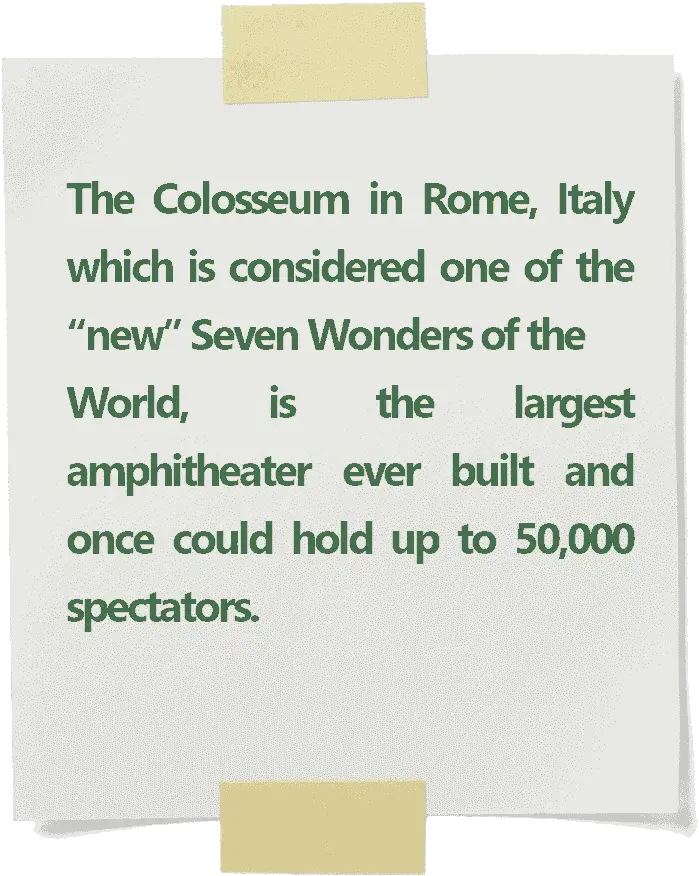
A. Incorrect. This edit would remove the comma at the end of the nonrestrictive clause, which
should be set off by commas at the beginning and the end.
B. Incorrect. When a name has more than one element, a comma is used to separate the
elements for clarity.
C. Incorrect. A comma after “built” would separate the dependent clause “and once could hold
up to 50,000 spectators” from the subject of the main clause. The dependent clause uses the
subject from the main clause, so it must stay connected.
D. CORRECT. The sentence needs a comma to set off the clause “which is considered one of the
‘new’ Seven Wonders of the World,” because the clause is not essential to the meaning of the
sentence (nonrestrictive clause). This option is correct because it places a comma where it is
needed, after “Italy,” to set off the nonrestrictive clause that follows.
Which sentence has a grammar error that should be corrected?
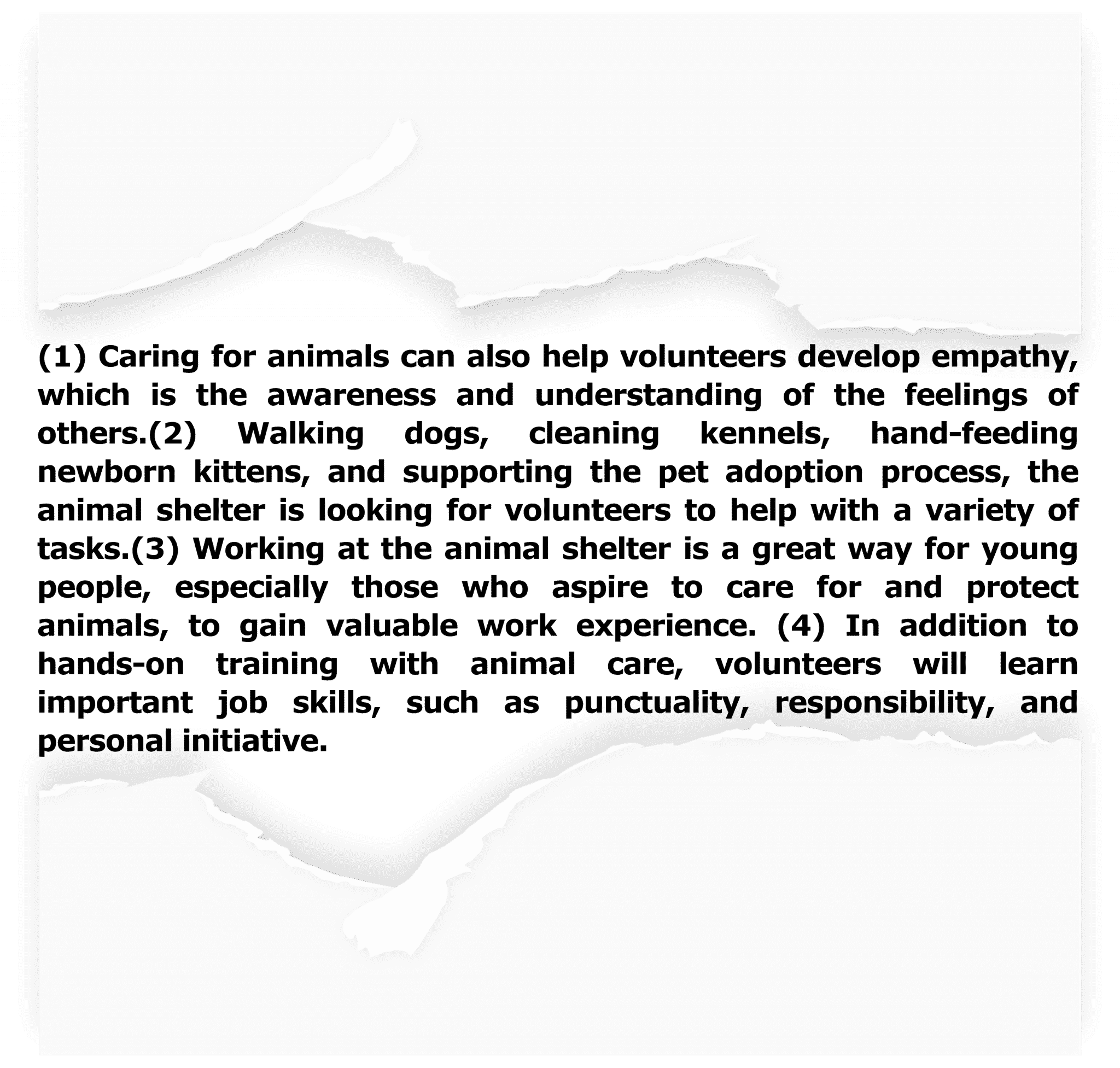
The question asks for the identification of the sentence in the paragraph that has an error in its
construction and should be revised.
A. Incorrect. Sentence 4 does not contain structural errors. The phrase “which is the awareness
and understanding of the feelings of others” in sentence 4 correctly modifies the word
“empathy.”
B. CORRECT. Sentence 1 contains a structural error. The sentence begins with a list of
modifying phrases: “Walking dogs, cleaning kennels, hand-feeding newborn kittens, and
supporting the pet-adoption process.” As written, this list modifies the closest noun phrase,
“the animal shelter,” which is illogical because the list describes tasks at the animal shelter,
not the shelter itself. The list should follow the word “tasks” at the end of the sentence, so
that it is closer to the word that it modifies.
C . Incorrect. Sentence 2 does not contain structural errors. The phrase “especially those who
aspire to care for and protect animals” in sentence 2 correctly modifies “young people.”
D. Incorrect. Sentence 3 does not contain structural errors. The structure of sentence 3 allows
the words “In addition to hands-on training with animal care” to correctly modify “volunteers
will learn.”
What would be the best way to rewrite this sentence?
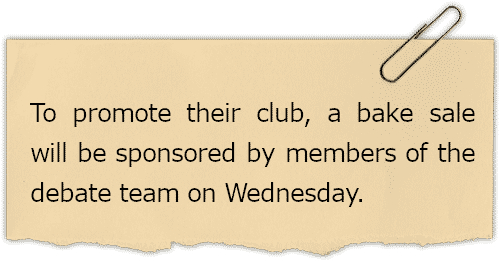
The question asks for the correct revision of the sentence.
A. CORRECT. The revision is correct because it includes the phrase “to promote their club”
clearly modifying “members of the debate team.”
B. Incorrect. The revisions do not fix the error that “to promote their club” modifies “a bake
sale.”
C. Incorrect. While the revision clarifies that “to promote their club” relates to the “members of
the debate team,” the rest of the sentence is poorly written because the insertion of “on
Wednesday to promote their club” in the middle of the sentence interrupts the main clause,
“Members of the debate team will sponsor a bake sale.”
D. Incorrect. The revisions do not fix the error that “to promote their club” modifies “a bake
sale.”
What is the best method for combining sentences together?
(1) Scientists now believe that Jupiter may have as many as seventy-nine moons.
(2) One of Jupiter’s moons is named Io.
(3) Io has the greatest number of active volcanoes in the solar system.
The question asks for the best way to combine the sentences.
A. Incorrect. Although the sentence incorporates all three ideas from the original sentences and
correctly places the detail about the number of active volcanoes on Io in a dependent clause,
this option is incorrect because it presents an imprecise relationship between the ideas. By
using the conjunction (connecting word) “and,” the sentence construction suggests that
scientists “now believe” not just that “Jupiter may have as many as seventy-nine moons” but
that “one of them is named Io,” instead of presenting Io as an example of one of Jupiter’s
moons.
B. Incorrect. Although the sentence incorporates the ideas presented in the three original
sentences, it is incorrect because the combination suggests an incorrect relationship between
the ideas. By beginning with “Io,” the sentence places emphasis on the moon and the detail
about the number of active volcanoes rather than the key idea that “scientists now believe
that Jupiter may have as many as seventy-nine moons.” Since Io is an example of one of
Jupiter’s moons, the details about Io should follow and be subordinate to the main clause,
which provides new information about the number of Jupiter’s moons in general.
C. Incorrect. The sentence incorporates the key ideas from the three original sentences, but its
structure does not accurately present the relationship between these ideas. The beginning of
the sentence includes the detail about Io having “the greatest number of active volcanoes in
the solar system” before specifying that Io is one of the seventy-nine moons of Jupiter. The
presentation of the details about Io at the beginning lessens the emphasis of the key idea
that “scientists now believe that Jupiter may have as many as seventy-nine moons.”
D. CORRECT. The sentence is the best way to combine these sentences because it uses a
complex sentence to present ideas clearly and precisely, and it shows the relationship
between the ideas in the three sentences. The sentence starts by stating the number of
moons scientists now believe Jupiter to have and then specifies that one of those moons is
named Io. The dependent clause “which has the greatest number of active volcanoes in the
solar system” immediately follows the word “Io” to provide additional information about the
moon. A dependent clause contains a subject (“which,” referring to “Io”) and a verb (“has”)
but is not a complete sentence on its own.
In this paragraph, which two revisions are required?
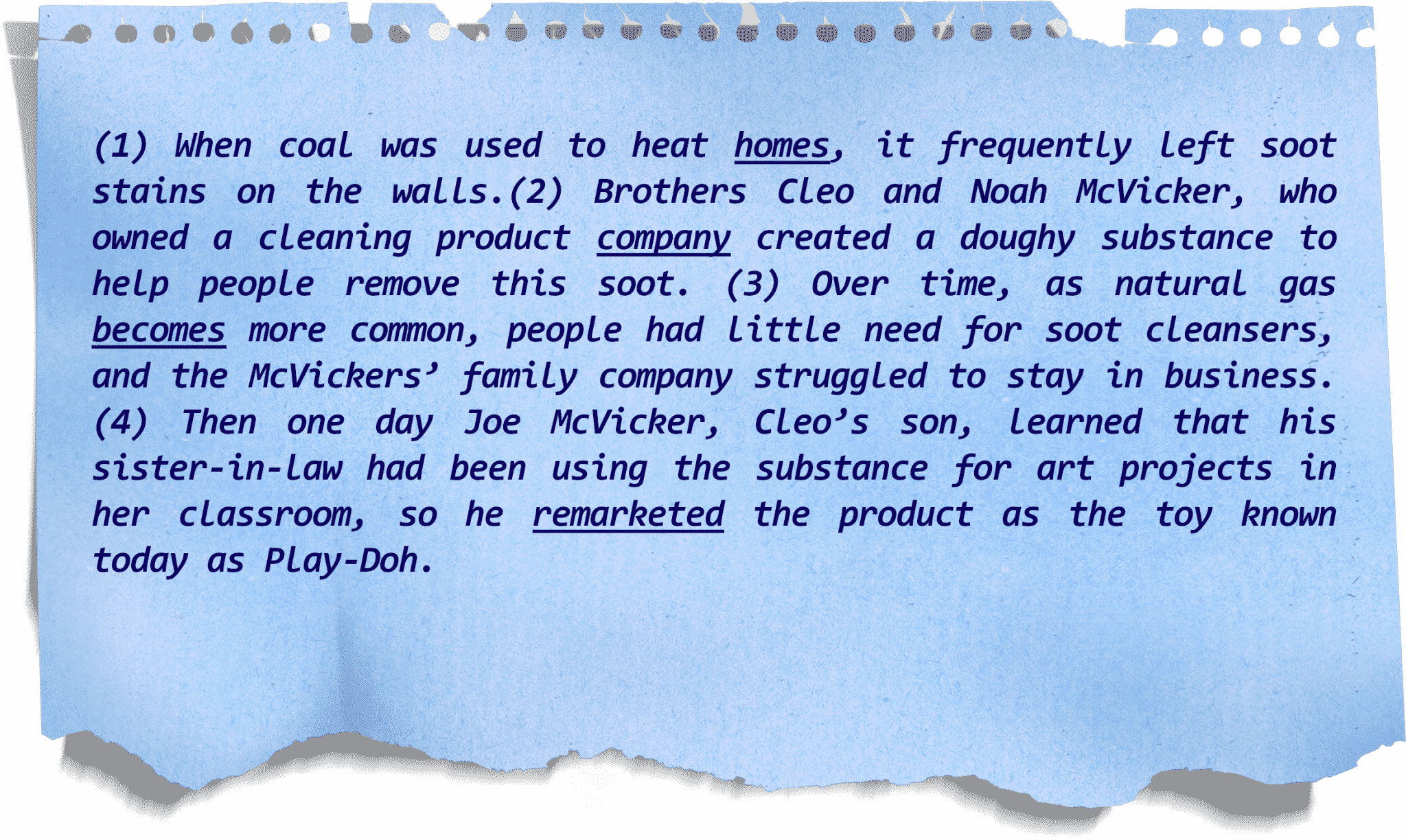
The question asks for the pair of revisions needed to correct the errors in the paragraph, which
appear in sentence 2 and sentence 3.
A. CORRECT. This option is the only choice that revises the errors in both sentence 2 and
sentence 3. In sentence 2, a comma needs to follow the word “company” to set off the
phrase “who owned a cleaning product company.” A comma is necessary because the phrase
is a nonrestrictive clause: the phrase provides extra information about Cleo and Noah
McVicker’s line of work, but the phrase is not necessary in order to understand the meaning
of the sentence. The second error is in sentence 3, which incorrectly shifts the verb into the
present tense. The clause “as natural gas becomes more common” should be “as natural gas
became more common.”
B. Incorrect. The comma after the word “homes” in sentence 1 is necessary for separating the
subordinate clause “When coal was used to heat homes” from the main clause. The only edit
needed in this pair is in sentence 3, which incorrectly shifts the verb into the present tense.
The clause “as natural gas becomes more common” should be “as natural gas became more
common.”
C. Incorrect. In sentence 2, a comma needs to follow the word “company” to set off the phrase
“who owned a cleaning product company.” In sentence 4, the word “remarketed” is in the
past tense established in the rest of the paragraph and should not change to the past perfect
tense “had remarketed.”
D. Incorrect. The comma after the word “homes” in sentence 1 is necessary for separating the
subordinate clause “When coal was used to heat homes” from the main clause. In
sentence 4, the word “remarketed” is in the past tense established in the rest of the
paragraph and should not change to the past perfect tense “had remarketed.”"
Which sentence should come after sentence 3 to best introduce the passage's topic?
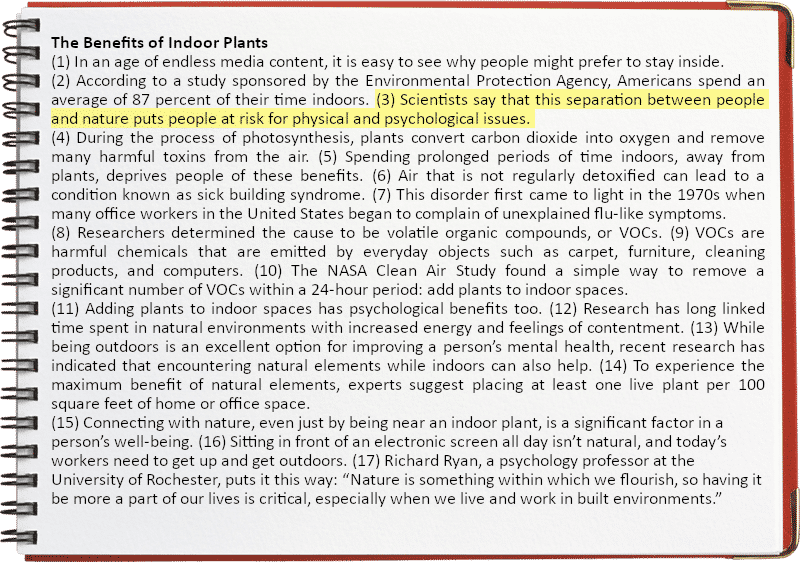
The question asks which sentence should follow sentence 3 to best introduce the topic of the
passage.
A. Incorrect. While the sentence refers to how time away from nature can affect health and
well-being, the vague wording (“little connection to nature”) makes this sentence too broad
to introduce the topic of the passage, and thus, it should not follow sentence 3.
B. CORRECT. The sentence introduces the overall topic by previewing the main ideas in the
passage. It introduces the connection between natural elements and well-being (“a healthy
bridge”) and sets up the main argument of the passage (“Placing plants in homes and
offices” can increase people’s well-being).
C. Incorrect. Although sentence 3 mentions the connection between “people and nature,” this
sentence references the importance of spending time near plants while both indoors and
outdoors. However, the passage focuses specifically on the benefits of having indoor plants.
D. Incorrect: Though the sentence describes a reason why indoor plants are important (“For
[people’s] personal health and well-being”), the topic of the passage is related to the need
for indoor plants, not the need for people to spend more time outdoors.
At the start of sentence 5, which transition word or phrase should be used?
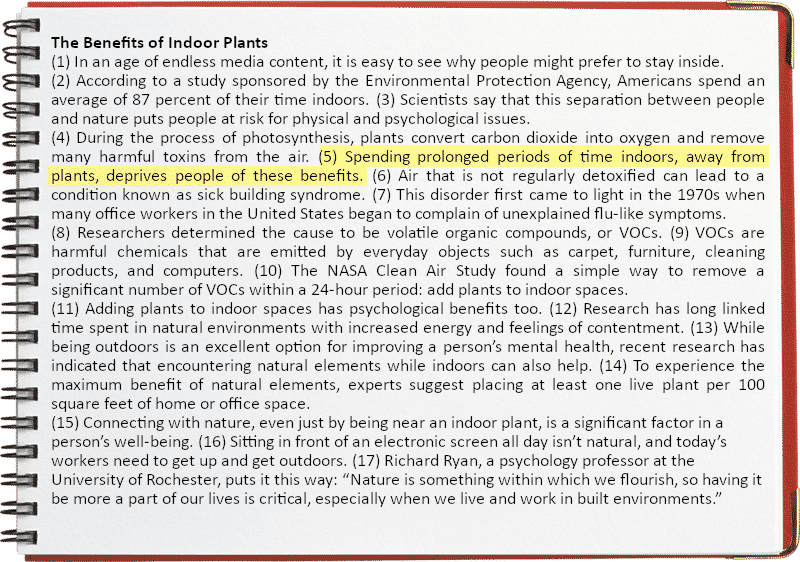
The question asks for the transition word or phrase that should be added to the beginning of
sentence 5.
E. Incorrect. Although sentence 4 describes a positive idea (plants are beneficial) and
sentence 5 describes a negative idea (deprivation), the transition phrase “In contrast”
conveys an inaccurate relationship between the ideas in the sentences. Sentence 5 is not
arguing against the beneficial effect of plants and should not begin with a transition that
implies opposition.
F. Incorrect. The transition phrase “As a result” conveys a cause-and-effect relationship that
does not exist between the ideas in sentence 4 and sentence 5. Although the plants’
conversion of carbon dioxide into oxygen removes harmful toxins from the air, the process of
photosynthesis (sentence 4) does not deprive people of the plants’ benefits (sentence 5).
G. CORRECT. The relationship between the ideas in the sentences is correctly conveyed with
the transition word “Unfortunately,” which signals the shift from the positive effect described
in sentence 4 (plants are helpful) to the emphasis in sentence 5 that the positive effect is
dependent on proximity to plants.
H. Incorrect. Although the passage describes why people should spend time in close proximity
to plants, the idea in sentence 5 is actually in opposition to the idea in sentence 4 rather than
an elaboration of it. The transition word “Primarily” incorrectly suggests that the sentences
describe the same idea.
To best support the information offered in the passage, which conclusion statement should come after sentence 17?
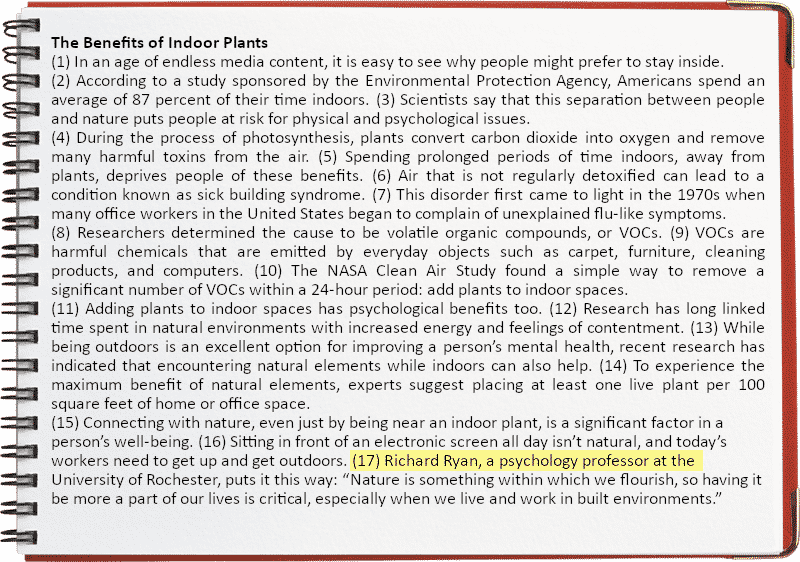
The question asks for the concluding sentence that should follow sentence 17 to best support the
information presented in the passage.
A.Incorrect. Although the sentence notes the positive impact that houseplants can have on air
quality, the sentence does not logically follow the preceding information about the overall
benefits to a person’s health and well-being.
B.Incorrect. Although the sentence describes plants as “vital to our wholeness and wellness,”
the detail about the absorption of carbon dioxide from the air is overly specific and does not
capture the broader argument presented in the passage (that placing plants indoors “is a
significant factor in a person’s well-being” [sentence 15]).
C.Incorrect. The sentence’s reference to particular types of plants suitable for indoor spaces
supports the idea of incorporating nature into a home or office, but the sentence does not
address the benefits people can experience for doing so and thus does not present a logical
conclusion for the information in the passage.
D.CORRECT. The sentence directly presents the argument of the passage (“More people should
consider bringing natural elements inside”) and supports the central ideas in the second and
third paragraphs relating to the health and psychological benefits of having indoor plants.